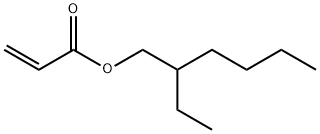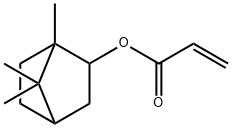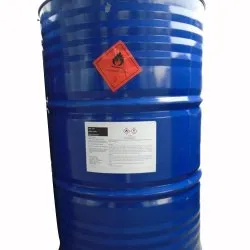2-Ethylhexyl acrylate
Synonym(s):(±)-Acrylic acid 2-ethylhexyl ester;2-Ethylhexyl acrylate;Acrylic acid 2-ethylhexyl ester
- CAS NO.:103-11-7
- Empirical Formula: C11H20O2
- Molecular Weight: 184.28
- MDL number: MFCD00009495
- EINECS: 203-080-7
- SAFETY DATA SHEET (SDS)
- Update Date: 2025-12-17 09:49:22

What is 2-Ethylhexyl acrylate?
Description
2-Ethylhexyl acrylate is a combustible, colorless liquid with a pleasantodor. Molecular weight = 184.31;Boiling point = 214℃; Freezing/Melting point = -90℃;Flash point = 82℃; Autoignition temperature = 252℃.Explosive limits: LEL = 0.8%; UEL = 6.4%. HazardIdentification (based on NFPA-704 M Rating System):Health 2, Flammability 2, Reactivity 2. Insoluble in water
Chemical properties
A colorless and transparent liquid that is nearly insoluble in water but can be mixed with alcohol and ether. It was present in a surgical tape and caused allergic contact dermatitis in a patient.
The Uses of 2-Ethylhexyl acrylate
2-ethylhexyl acrylate is a monomer for plastics, protective coating, paper treatment, water-based paints, UV-curable coatings, and inks; in so me acrylicbased adhesive tapes.
Definition
ChEBI: 2-Ethylhexyl acrylate is an ester of enoic acid. It is commonly used as a plasticizing co-monomer in the production of resins, which are utilized in various applications such as adhesives, latex, paints, textile and leather finishes, and coatings for paper.
Preparation
2-Ethylhexyl acrylate is obtained by esterifying acrylic acid and 2-ethylhexanol with sulfuric acid as a catalyst, and subsequently neutralizing, dealcoholizing and rectifying the mixture.
General Description
2-ethylhexyl acrylate appears as a clear colorless liquid with a pleasant odor. Less dense than water and insoluble in water. Vapors heavier than air. Flash point 180 °F. Used in making of paints and plastics.
Air & Water Reactions
Insoluble in water.
Reactivity Profile
2-Ethylhexyl acrylate polymerizes readily in the presence of heat and light generating much heat; reacts with strong oxidants. REF [Handling Chemicals Safely, 1980. p. 235].
Hazard
Questionable carcinogen.
Health Hazard
Inhalation of concentrated vapor causes drowsiness and convulsions. Liquid causes irritation of eyes and may irritate skin on prolonged exposure. Ingestion produces same symptoms as inhalation.
Fire Hazard
Behavior in Fire: Heat can result in a severe polymerization with rapid release of energy. Sealed containers may rupture explosively if hot.
Flammability and Explosibility
Not classified
Potential Exposure
A potential danger to those involved in the use of this monomer as a feedstock for chemical syntheses; in the manufacture of plastics; protective coatings, including water-based paints; in paper treatment; the production of emulsion polymers.
First aid
Skin Contact: Flood all areas of body thathave contacted the substance with water. Do not wait toremove contaminated clothing; do it under the water stream.Use soap to help assure removal. Isolate contaminatedclothing when removed to prevent contact by others. EyeContact: Remove any contact lenses at once. Flush eyeswell with copious quantities of water or normal saline for atleast 20- 30 min. Seek medical attention. Inhalation: Ifconvulsions are not present, give a glass or two of water ormilk to dilute the substance. Assure that the person’s airwayis unobstructed and contact a hospital or poison centerimmediately for advice on whether or not to induce vomiting. Ingestion: If convulsions are not present, give a glassor two of water or milk to dilute the substance. Assure thatthe person’s airway is unobstructed and contact a hospitalor poison center immediately for advice on whether or notto induce vomiting.
Storage
: Color Code—Red: Flammability Hazard: Store ina flammable liquid storage area or approved cabinet awayfrom ignition sources and corrosive and reactive materials.Prior to working with this chemical you should be trainedon its proper handling and storage. Store in tightly closedcontainers in a cool, well-ventilated area or refrigeratoraway from oxidizers and light. Where possible, automatically pumpliquid from drums or other storage containers toprocess containers.
Shipping
Note: Unless inhibited, this material is a polymerization hazard. May be classified as a Combustible liquid, n.o.s. This class of compounds requires no particularshipping label. It falls in Hazard Class 3 and Packing GroupIII. Each reference to a Class 3 material is modified to read“COMBUSTIBLE LIQUID” when that material is reclassified in accordance with y173.150 (e) or (f) of this subchap_x0002_ter, or has a flash point above 60.5℃/141° F but below93℃/200°F.
Incompatibilities
Unless inhibited, sunlight, heat, contaminants, or peroxides can cause dangerous polymerization. Vapors are uninhibited and may polymerize, blocking vents. Violent reaction with strong oxidizers, with risk of fire and explosions. May form explosive mixture with air. Incompatible with strong acids; aliphatic amines; alkanolamines.
Waste Disposal
Spray into incinerator with added flammable solvent.
Properties of 2-Ethylhexyl acrylate
| Melting point: | -90°C |
| Boiling point: | 215-219 °C(lit.) |
| Density | 0.885 g/mL at 25 °C(lit.) |
| vapor density | 6.4 (vs air) |
| vapor pressure | 0.15 mm Hg ( 20 °C) |
| refractive index | n |
| Flash point: | 175 °F |
| storage temp. | Store below +30°C. |
| solubility | 0.1g/l |
| form | Liquid |
| color | Clear |
| Odor | Ester like odour |
| explosive limit | 0.9-6.0%(V) |
| Water Solubility | <0.1 g/100 mL at 22 ºC |
| BRN | 1765828 |
| Exposure limits | ACGIH: TWA 5 mg/m3 NIOSH: TWA 5 mg/m3 |
| Stability: | Stability Stable, but polymerizes readily, so is usually inhibited with hydroquinone or its monomethyl ether. Susceptible to hydrolysis. Combustible. Incompatible with oxidizing agents. |
| CAS DataBase Reference | 103-11-7(CAS DataBase Reference) |
| IARC | 2B (Vol. 60, 122) 2019 |
| NIST Chemistry Reference | 2-Propenoic acid, 2-ethylhexyl ester(103-11-7) |
| EPA Substance Registry System | 2-Ethylhexyl acrylate (103-11-7) |
Safety information for 2-Ethylhexyl acrylate
| Signal word | Warning |
| Pictogram(s) |
 Exclamation Mark Irritant GHS07 |
| GHS Hazard Statements |
H315:Skin corrosion/irritation H317:Sensitisation, Skin H335:Specific target organ toxicity, single exposure;Respiratory tract irritation |
| Precautionary Statement Codes |
P261:Avoid breathing dust/fume/gas/mist/vapours/spray. P264:Wash hands thoroughly after handling. P264:Wash skin thouroughly after handling. P271:Use only outdoors or in a well-ventilated area. P272:Contaminated work clothing should not be allowed out of the workplace. P280:Wear protective gloves/protective clothing/eye protection/face protection. P302+P352:IF ON SKIN: wash with plenty of soap and water. |
Computed Descriptors for 2-Ethylhexyl acrylate
| InChIKey | GOXQRTZXKQZDDN-UHFFFAOYSA-N |
2-Ethylhexyl acrylate manufacturer
Global Impex.
New Products
4,4-Difluoropiperidine hydrochloride tert-butyl 9-methoxy-3-azaspiro[5.5]undecane-3-carboxylate Indole Methyl Resin N-Isopropylurea N,N-Dicyclohexylcarbodiimide(DCC) MELDRUMS ACID 5-METHYLISOXAZOLE-4-CARBOXYLIC ACID Magnessium Bis glycinate Zinc ascorbate 1-bromo-2-butyne 2-acetamidophenol 9(10H)-anthracenone Erythrosin B, 4-Piperidinopiperidine 2-((4-morpholinophenylamino) (methylthio) methylene) malononitrile 2,4-dihydroxybenzaldehyde 3-(4-morpholinophenylamino)-5-amino-1H-pyrazole-4-carbonitrile Methyl 2-methylquinoline-6-carboxylate 2,6-dichloro-4-nitropyridine 4-Bromo-2-chlorobenzonitrile 2-(benzylamino)acetic acid hydrochloride 4-(tert-Butoxycarbonylamino)but- 2-ynoic acid 3,4-dihydro-2H-benzo[b][1,4]dioxepine 1-Phenyl-1-cycloprppanecarboxylicacidRelated products of tetrahydrofuran








You may like
-
 2-ETHYL HEXYL ACRYLATE. 99%View Details
2-ETHYL HEXYL ACRYLATE. 99%View Details -
 2-Ethylhexyl acrylate CAS 103-11-7View Details
2-Ethylhexyl acrylate CAS 103-11-7View Details
103-11-7 -
 2-Ethylhexyl Acrylate extrapure CAS 103-11-7View Details
2-Ethylhexyl Acrylate extrapure CAS 103-11-7View Details
103-11-7 -
 2Ethyl Hexyl Acrylate CASView Details
2Ethyl Hexyl Acrylate CASView Details -
 2-Ethyl hexyl acrylate, GR 99%+ CAS 103-11-7View Details
2-Ethyl hexyl acrylate, GR 99%+ CAS 103-11-7View Details
103-11-7 -
 2-Ethylhexyl Acrylate CASView Details
2-Ethylhexyl Acrylate CASView Details -
 2-Ethylhexyl Acrylate Liquid CAS 103-11-7View Details
2-Ethylhexyl Acrylate Liquid CAS 103-11-7View Details
103-11-7 -
 Liquid 2-Ethylhexyl AcrylateView Details
Liquid 2-Ethylhexyl AcrylateView Details
103-11-7
